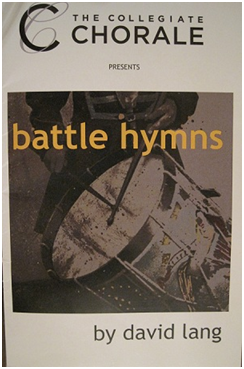The Collegiate Chorale: David Lang’s battle hymns
presented on the hangar deck auditorium of the USS Intrepid Sea, Air and Space Museum.

The Collegiate Chorale: David Lang’s battle hymns
[avatar user=”Jean Ballard Terepka” size=”96″ align=”left”] Jean Ballard Terepka, Music Reviewer[/avatar]The Collegiate Chorale, together with singers from the Veteran Artist Program and the Manhattan Girls Chorus, presented the New York premiere of David Lang’s 2009 battle hymns on May 15, 2014 in the hangar deck auditorium of the USS Intrepid Sea, Air and Space Museum. James Bagwell, Music Director of The Collegiate Chorale, conducted; the performance was directed by Ted Sperling, The Collegiate Chorale’s Artistic Director.
David Lang’s forty-five minute long piece is divided into five movements, all a cappella, with the exception of the fourth movement in which a snare drum is played throughout. Three of the five movements the first, third and fifth use Stephen Foster (1826-1864) song texts; the text of the second movement is Lang’s adaptation of Civil War soldier Sullivan Ballou’s letter to his wife, a now famous document that encapsulates the ways in which the war shredded domestic lives; the text of the fourth movement is Lincoln’s core statement about both identity and citizenship, As I would not be a slave, so I would not be a master.
The Collegiate Chorale blogger Janet B. Pascal wrote the exceptionally clear, thoughtful program notes for this May 15 performance. Her comments highlighted the history of Lang’s piece and some of its meanings.
Everything about this performance of battle hymns should have been wonderful, but the evening fell short of its possibilities: in spite of everyone’s passionate best efforts and in spite of individual moments of clarity and effectiveness, the work’s realization as a whole did not meet its full potential.
Pascal began her program notes by quoting Los Angeles Times music critic Mark Swed’s often-quoted statement about Lang, There is no name yet for this kind of music. That’s alright. We’ll just call it David Lang’s music. ‘Post-minimalist’ and ‘innovative’ are useful descriptors. But choral music, if it is indeed text based and battle hymns contains carefully chosen, interesting texts whose meanings derive in part from their relationships and juxtapositions needs to make the texts intelligible.
In the huge, acoustically peculiar space of the Intrepid’s hangar auditorium, battle hymns‘ words were awfully hard to hear. Although Michelle Oesterle, the artistic director of the Manhattan Girls Chorus, does seem to have trained her young singers with attention to diction and although some of the soloists sang clearly, much of the what the chorus sang was very hard to understand. Adults and youngsters alike were consistently focused and alert to Bagwell’s energetic direction, but the final result had more to do with human musical sound than with words. To the extent that revelation of the universality of both hope and suffering in any war, on the battlefield and at home, in public discourse and in the privacy of the heart is one of battle hymns‘ purposes, the intelligibility of actual individual texts may not matter. This performance did convey the universality of human responses to war.
But in fact the texts do matter: Lang’s reordering and restructuring of the elements of Sullivan Ballou’s letter into an alphabet of lived experience make clear how deeply committed he is to the texts’ power. So the lack of textual clarity in this concert constituted a lamentable flaw.
Over the course of the evening, the performance did become increasingly compelling as it unfolded.
The third movement moved from inquiry to urgency, from fact-quest to heart-break as the chorus asked, Was my brother in the battle? The music here reflected emotional moods from fear to anger and hope to despair. Dissonances and unresolved chords embodied the basic human inability to make sense of things in battlefield stories.
The success of the fourth movement lay in the connections between the relentless and relentlessly simple martial snare drum and the simple slavery-abhoring text. Lincoln’s words, layered over and over on each other and paced so as to emphasize individual words and phrases, were transformed into a musical lectio divina, revealing both slavery’s and war’s terrible power. Drummer Brendan Ko, a junior at Frank Sinatra School of the Arts, was first rate as he marched the music forward into meaning.
The fifth movement did much to provide this performance with its coherence and effectiveness. Here, Lang used the Manhattan Girls Chorus to offer optimism and hope to the adults’ desires for sorrow’s departure. In previous movements, the girls’ sweet treble voices had added a narrative element of childhood and youth. Now, they took on a more sacred function: they were angelic. Whereas in earlier parts of battle hymns, the girls’ movements in and around the audience had not been particularly clear in purpose, in this last part of the piece, the girls’ placement in the back balcony, the Discovery Deck, was an effective replication of Gabrieli’s or Langlais’s or Holst’s choruses’s multiple placement around churches and cathedrals or concert halls, an assertion that human prayers will penetrate into God’s heavens. In short, battle hymns‘ fifth movement, Beautiful Dreamer, by making explicit references to sacred choral music over many centuries, made the humanity of the previous movements more accessible and intelligible.
The final moments of battle hymns were indeed beautiful.
Perhaps the acoustics of the Intrepid’s cavernous belly worked against the complete success of this performance; perhaps difficulties in understanding the words of the work’s texts militated against access to the full riches of the work. Though this concert was not The Collegiate Chorale’s best, the Chorale’s commitment both to community engagement and to the performance of innovative, non-traditional works remain entirely laudable.
The Collegiate Chorale: David Lang’s battle hymns
May 15, 2014 at 7:30
Intrepid Sea, Air and Space Museum
212-245-0072
http://www.intrepidmuseum.org
The Collegiate Chorale
115 East 57th St, 11th Floor
646-202-9623
http://www.collegiatechorale.org






Leave a comment